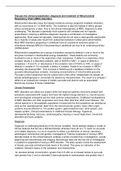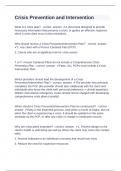Discuss the clinical presentation, diagnosis and treatment of Mitochondrial
Respiratory Chain (MRC) disorders.
Mitochondrial disorders have the highest incidence among congenital metabolic disorders,
with an occurrence of 1 in 5000 births. The incidence is also the highest in ethnic groups
where consanguinity is seen. Due to the clinical heterogeneity of MRC, diagnosis is often
challenging. The disorder is generally multi-systemic with variable and non-specific
presentations meaning a definitive diagnosis requires a combination of investigative
approaches. Most cases are sporadic, meaning they do not have a clear genetic association,
but a majority of cases also result from autosomal recessive nuclear gene abnormalities.
Most MRC disorders presenting in childhood have an autosomal recessive pattern of
inheritance whereas MRCD’s first presenting in adulthood are due to an underlying primary
mtDNA defect.
Mitochondrial cytopathies are a group of disorders caused by defects in one or more of the
enzymes involved in mitochondrial energy metabolism. These defects are commonly
localised to one or more of the respiratory chain complexes. A defect in a respiratory chain
complex results in a disturbed oxidation ratio of NADH to NAD +, in cases of defects in
complexes I, III and IV, or disturbance in the oxidation ratio of FADH 2 to FAD, in cases of
defects in complex II. For example, a defect in complex I leads to an increase in NADH,
ultimately decreasing NAD+. This increase in NADH exerts a feedback inhibition on the
pyruvate dehydrogenase complex, increasing concentrations of mitochondrial pyruvate.
Pyruvate is then transported into the cytosol and is then either metabolised into lactate via
lactate dehydrogenase or converted into alanine by transamination. The result of a complex I
defect is an intracellular increase in lactate, pyruvate and alanine and an associated
blood/urea increase of these metabolites.
Clinical Presentation
MRC disorders can affect any system within the body but patients commonly present with
symptoms associated with organs that have the highest energy demand i.e. neuromuscular
and neurological complaints are the most common presentations. Childhood manifestations
of MRC disorders are often progressive and more often fatal than adult onset disease. The
clinical spectrum in the paediatric population is broad and the first symptoms can develop as
early as the neonatal period. Apart from the neuromuscular system, many other organ
systems may be affected i.e. the cardiac system, gastrointestinal tract, renal system, and
hepatic system. Clinical presentations in childhood include lethargy, hypotonia,
developmental delay, seizures, cardiomyopathy, hearing or visual impairment, movement
disorders and lactic acidosis.
Diagnosis
Diagnosis is challenging because of the clinical variability. Some patients display a cluster of
clinical features that fall into a defined disorder whereas many do not. To reach an accurate
and reliable diagnosis, it is as an essential to utilise a combination of clinical, laboratory,
pathological, biochemical and genetic investigations. Patients suspected of having a MRC
disorder based on the clinical features undergo a series of preliminary investigations, usually
beginning with biochemistry and imaging. Biochemical tests are the first line of investigation
if a patient is suspected of having a MRC disorder. The tests usually involve the assessment
of lactate, pyruvate and ketone body levels in the blood. This gives an indication of the
oxidation-reduction status of the cytoplasm and mitochondria.
An elevated lactate concentration, greater than 2.5 mM, an increased lactate to pyruvate
ratio greater than 2 and an elevated 3-hydroxybutyrate to acetoacetate ratio greater than 2





